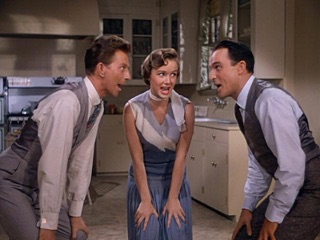...is now a musical
Something I love about Singin' in the Rain is that for a movie that is essentially about the use of sound in film, it constantly draws your attention--if you're paying attention--to the moments where sound and image do not really go together. In the Cosmo and Don flashback at the beginning of the film, for example, they are so obviously not playing those fiddles--that's part of the fun of that performance--that at first you might not notice that the tap noises you're hearing do not match their steps. Those sounds weren't recorded on set but added later; just as the fiddle music is not coming from those fiddles, the tap sounds are not coming from those shoes. And, this is what film does. It gives us sounds and images that are not real. Characters that are not real. Stories that are not real.
Except, all if it is real, if you're like me. Sitting in the darkened theater, or the living room, the sounds and images become real, the characters become real, and the stories become real. There are limits to this, of course. We were actually talking about this tonight in Performance Studies class with Brecht's distinction between dramatic theater and epic theater--basically, the former is the kind of thing Singin' in the Rain is, entertainment not advocacy toward action, not interacting with the audience. We were not talking about Singin' in the Rain, though. Just theater more generally. We were talking about Singin' in the Rain (and we watched most of it) just last week in Media Theory class. Our instructor fastforwarded through bits here and there, especially the majority of a few of the song and dance numbers.
Meanwhile, as I've gotten to rambling, the movie continues. A great scene right now, Don and Lina having a conversation bordering on an argument while acting--it's still a silent film--like they are in love.
Followed soon thereafter by the "Beautiful Girls" number, which is... perplexing. Especially the lead in montage of dancers going into it. It's like the makers of Singin' in the Rain thought we needed a break. Sure, there's some semblance of commentary on the role of Lina Lamont with this song, except it seems like this song is sincere, not ironic or satiric. But, gender is not a topic for today, so let's move on.
Before we get inside the studio and Don sets up the artificial scene to talk to Kathy, they have a real talk outside, but if you notice, there's a breeze blowing on her, just like there will be after he sets up that fan inside. This scene, is just as artificial as the one he's about to create inside...
I was curious about this song--"You Were Meant for Me"--and found some interesting details about the songs in this movie. While I've seen the movie a few times before, even (as I said) as recently as last week, I didn't know too much about the movie before recently. Thing is, many of the songs in this film were not written for this film. "You Were Meant for Me" was in The Broadway Melody in 1929 (as were a couple parts of that "Beautiful Girls" bit). The title song was probably written in 1929 and first performed by Doris Eaton Travis in The Hollywood Music Box Review.

That the songs are mostly not original to this movie actually adds to the artificiality of the film, though. Just like the sound in The Dueling Cavalier (the film within the film, in case you don't know) is augmented to be well beyond what would have actually been recorded, the pearls a little too loud, Don's cane hits the floor (which would not have been miked) too loudly. It makes The Dueling Cavalier even more of a joke than it is, but it also draws attention to this film being a film just as that film is a film. And, now they're all dancing to "Good Morning" (from 1939's Babes in Arms, by the way) and I really doubt these characters wear tap shoes all the time, but what do we hear? Tap sounds.
Same thing for "Singin' in the Rain."
Expect an entire entry this week about the "Broadway Melody" piece, so I will not say much on this Day 1 except that it really doesn't fit the rest of the movie. Like "Beautiful Girls" it seems to serve little purpose except to give the audience a break from the larger story. And, to show off a whole lot of costumes, I guess. Maybe Walter Punkett (that's the costume designer) had some blackmail material on Gene Kelly. I don't know.
Then there's the last act. Lina learns what's going on--and I kind of feel sorry for her--and manipulates R.F. into not promoting Kathy--which makes me not feel so bad for Lina anymore... that was a quick turnaround.
Expect an entry--probably the same one that comments on gender roles in the film--about the voice dubbing, and the behind-the-scenes dubbing that kind of did the same thing. For now, I'll just say, it's too bad for Betty Noyes.
Anyway, it's musical month at the Groundhog Day Project. This ought to be fun.
Comments
Post a Comment